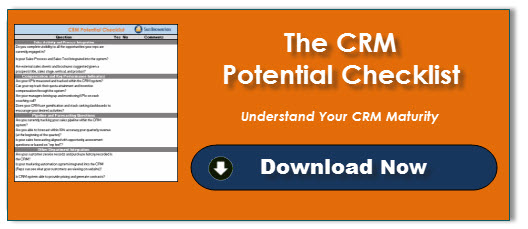One of the biggest purchases a Sales Department makes is the CRM system. Companies that have successfully implemented a system tout benefits like:
- Increased rep productivity
- Greater pipeline transparency
 More aligned sales reps and materials
More aligned sales reps and materials- Integration of multiple systems to automate routine tasks.
However, we’ve witnessed a varied success rate across CRM implementations. Most organizations are still waiting for these promised gains. In many of these deployments the CRM system exists in a silo. The software never lives up to expectations. And the sales team ultimately reverts to old habits. But it doesn’t have to be this way.
Find out where your CRM system is optimized and where you can improve. Download our CRM Potential Checklist to help you maximize your system investment. Get your copy by signing up for SBI’s 7th annual research tour: “How to Make Your Number in 2014: A Sales Strategy You Can Execute“.
Here are the most common underutilized CRM system formats we see:
The Pipeline Tool: Sales reps record projected deals and opportunities in the CRM. Names of companies and contact information are non-existent. The software simply replaces an old spreadsheet forecasting system.
The Rolodex tool: Customer contact information is entered, but opportunities are sparse. Reps record interactions and activities, but there are no deals (or dollar amounts). It’s simply an account/contact and activity database.
The Compensation Tool: Reps hang onto opportunities until the last minute. Then when the deal closes, they enter it. Reps are paid based on the data in the CRM. There is no value to management, as every deal is seen in the rearview mirror.
The Technology brag: The CRM was purchased because it was the hot new technology. Nobody uses it or enters information in it. There is nothing under the hood.
Here’s the worst part: A CRM can actually be a great pipeline, activity, opportunity, and compensation tool. Most organizations simply don’t take the time to integrate and communicate the purpose correctly.
Why does CRM fail to achieve the desired results?
Incorrect Positioning: Management takes the usual soft approach to communicating the need for CRM. They say it’s not “Big Brother”. They say, “It will make you more effective“. Here’s what actually happens:
- The Complex System: Wait, didn’t you tell the reps they’d be more productive? Instead, management builds an overly complex CRM process. They don’t adequately train the reps (usually opting for a one day session). They ask for information irrelevant to the opportunity. And the system is buggy on rollout. All this makes the rep less productive. They give up.
- Big Brother: Management sings a tale of how the CRM system is really just to help the rep. This quickly disappears when a rep enters their first opportunity. All of a sudden, the manager is asking a hundred questions on every deal. They pull a rep into the office on a day with low activity. They call with questions on meeting notes. To avoid harrassement, the rep stops providing visibility.
- The Pseudo-Pipeline: Reps are supposed to enter every opportunity so managers can track pipeline. However, this is ususally a wild guess on some opportunities. Then, their manager adjusts the numbers. Next finance adjusts the numbers. Finally, the CSO massages them. Now all valuable data has been filtered out. No insight can be derived after all the revisions.
- No Accountability: Any initiative within the sales organization starts at the top. If the Sales VP doesn’t care about CRM, neither will their managers. If managers don’t care, neither will their reps. Managers frequently assume that weak carrots will enforce adoption. This is incorrect. The true test comes when a star performer refuses to adopt. They cite their track record as evidence why they don’t need it. A bad manager lets his top reps “do their own thing”. A good manager uses the stick in these situations. Every rep must enter the correct information for the system to work.
- No Help: Just entering opportunities into a computer doesn’t help a rep sell more. They need tools and resources embedded to assist them at each opportunity stage. This should be a Phase 2 addition. But management usually promises this capability to early. The result? A skeptical, disappointed sales organization.
So how should you re-engage on a lost CRM Project? Here’s how we advise our clients.
- Be honest about the prior launch’s shortcomings.
- Talk about benefits for each side (management and rep).
- Establish KPI and metrics.
- Build incentives and consequences into adoption.
- Don’t assume perfect understanding on day one. Continue to reinforce.
Today, the best sales teams have an optimized CRM system. They see opportunities to improve ahead of the competition. They achieve higher sales revenue per rep. They hit their number. Download our CRM Potential Checklist by signing up for SBI’s 7th annual research tour here: “How to Make Your Number in 2014: A Sales Strategy You Can Execute“.




